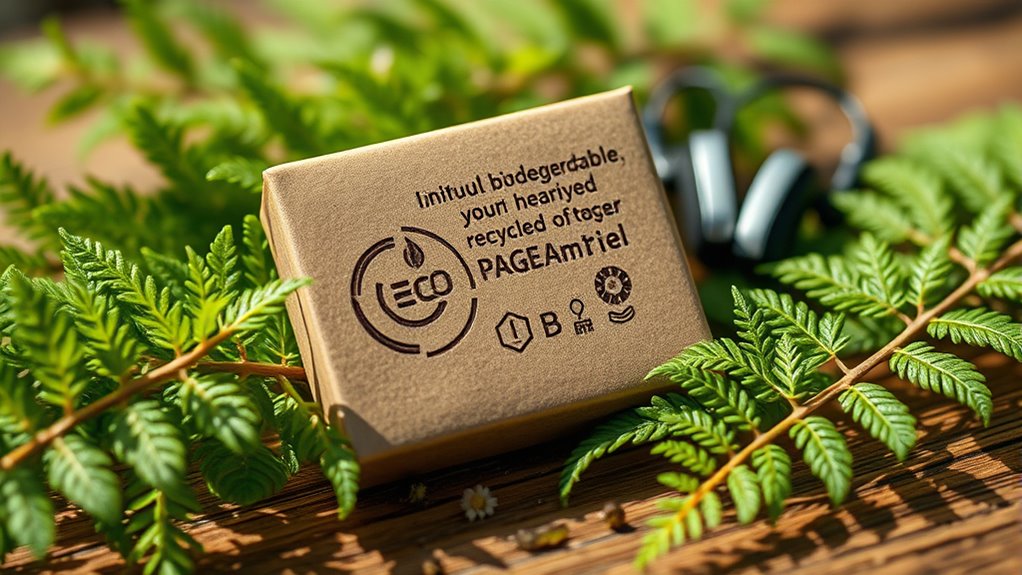Eco-friendly packaging in the hearing aid industry focuses on using biodegradable and recyclable materials that naturally break down, reducing waste and environmental impact. Companies are designing packaging that minimizes excess while maintaining durability, showing commitment to sustainability. They prioritize responsible sourcing and innovative designs aligned with eco-conscious consumer values. By choosing greener options, brands boost their reputation and support industry-wide efforts toward sustainability. Keep exploring to discover how these practices can benefit you and the environment.
Key Takeaways
- The industry is adopting biodegradable and compostable packaging materials to reduce environmental impact.
- Sustainable sourcing practices ensure raw materials are responsibly obtained without harming ecosystems.
- Packaging designs are optimized to minimize material use and incorporate eco-friendly materials effectively.
- Companies are establishing new supplier relationships to access high-quality, biodegradable packaging options.
- Emphasizing eco-friendly packaging enhances brand reputation and appeals to environmentally conscious consumers.

Have you ever wondered how the hearing aid industry is making strides toward sustainability? One of the key ways is through eco-friendly packaging that minimizes environmental impact. Manufacturers are increasingly turning to biodegradable materials, which break down naturally over time, reducing landfill waste and pollution. These materials include plant-based plastics, compostable papers, and other compostable substances that serve as effective packaging solutions without leaving harmful residues. By choosing biodegradable options, companies demonstrate a commitment to protecting the environment while still delivering quality products to consumers.
Hearing aid companies adopt biodegradable packaging to reduce waste and environmental impact.
Sustainable sourcing plays a crucial role in this shift. When companies prioritize sourcing materials responsibly, they ensure that the raw resources used in packaging are obtained in ways that don’t harm ecosystems or deplete natural resources. This means partnering with suppliers who practice responsible forestry, use renewable resources, and maintain ethical labor standards. Sustainable sourcing extends beyond just the materials—it’s about creating a supply chain that respects the environment and local communities, ultimately reducing the carbon footprint of the entire packaging process.
In the context of hearing aid packaging, these efforts are especially important, considering the volume of packaging used in the industry. From boxes and inserts to protective wraps, every element can be optimized for sustainability. Many companies are now designing packaging that not only uses biodegradable materials but also minimizes excess material to reduce waste. This approach appeals to environmentally conscious consumers who want products that align with their values. It also encourages industry-wide innovation, pushing competitors to adopt greener practices.
Implementing biodegradable materials and sustainable sourcing isn’t without challenges, but the benefits outweigh the hurdles. It often requires rethinking traditional packaging designs and establishing new supplier relationships. However, the long-term advantages include reducing environmental impact, appealing to eco-minded customers, and enhancing brand reputation. Customers increasingly prefer brands that demonstrate environmental responsibility, and eco-friendly packaging is a tangible way to show that commitment. Additionally, incorporating high-quality materials can improve the durability and overall perception of the packaging, reinforcing a company’s commitment to excellence and sustainability.
Frequently Asked Questions
How Does Eco-Friendly Packaging Impact Hearing Aid Pricing?
When considering how eco-friendly packaging impacts hearing aid pricing, you should think about the cost implications for manufacturers. Switching to sustainable materials may increase production costs initially, but it can boost consumer acceptance among eco-conscious buyers. While prices might rise slightly, the positive brand image and customer loyalty gained through sustainable packaging can offset these costs. Ultimately, eco-friendly packaging influences pricing strategies by balancing environmental benefits with market demands.
Are Eco-Friendly Materials as Durable as Traditional Packaging?
Think of eco-friendly materials like biodegradable plastics and recyclable materials as sturdy as traditional packaging. They’re designed to withstand everyday use, just like their conventional counterparts. While some may worry about durability, advancements guarantee these sustainable options hold up well over time. You’ll find that eco-friendly packaging offers the same strength and protection, making it a reliable choice that benefits both the environment and your hearing aid’s safety.
What Are the Challenges in Sourcing Sustainable Packaging for Hearing Aids?
You face sourcing sustainable packaging for hearing aids because recycling challenges can complicate waste management, and supplier availability may be limited. Finding reliable suppliers who prioritize eco-friendly materials can be tough, and ensuring the packaging meets durability standards adds to the difficulty. These hurdles require you to carefully evaluate options, build strong supplier relationships, and balance sustainability with practicality to create effective, eco-conscious packaging solutions.
How Do Eco-Friendly Packages Influence Customer Perception and Trust?
Think of eco-friendly packaging as the first impression that speaks volumes. When you use sustainable packaging, you show customers you care about the environment, which boosts consumer trust. This transparency fosters brand loyalty, making customers more likely to stick with you. Ultimately, eco-friendly packaging shapes how your audience perceives your brand, creating a positive image that resonates, builds credibility, and encourages repeat business.
What Regulations Support Eco-Friendly Packaging Practices in This Industry?
You should know that regulations support eco-friendly packaging practices by requiring the use of recyclable materials and setting standards for sustainable packaging. Packaging regulations often mandate that companies minimize environmental impact and guarantee recyclability. These rules help you adopt eco-friendly packaging, demonstrating your commitment to sustainability. By complying with these regulations, you build customer trust and strengthen your reputation as an environmentally responsible business.
Conclusion
Switching to eco-friendly packaging isn’t just good for the planet—it’s a savvy move that’ll impress your customers. By embracing sustainable options, you show you care about the environment and stay ahead of the curve. Remember, even in the age of the wheel, choosing greener solutions proves you’re committed to progress. So, don’t be left in the dust like the dinosaurs—adopt eco-friendly packaging today and make a positive impact that echoes through time.











